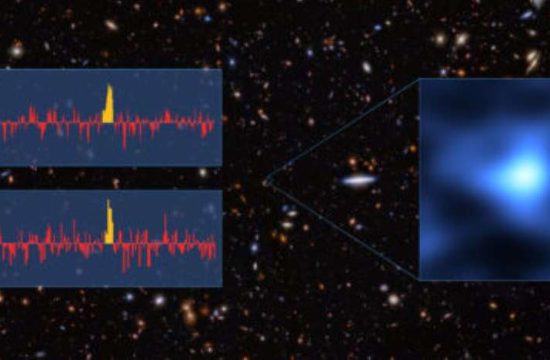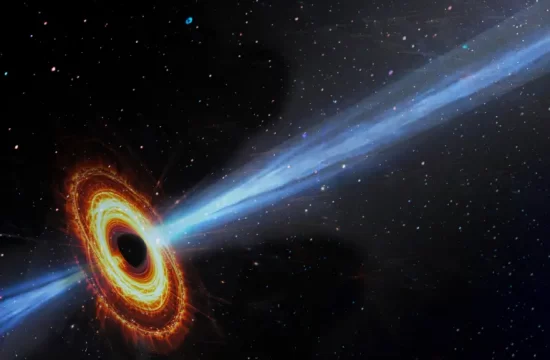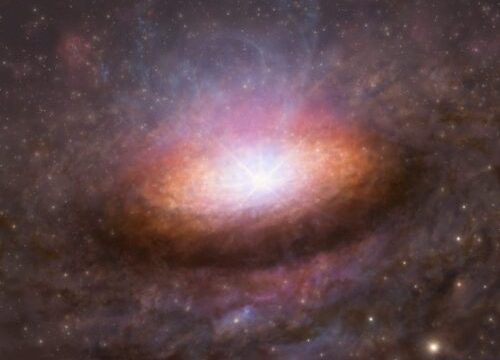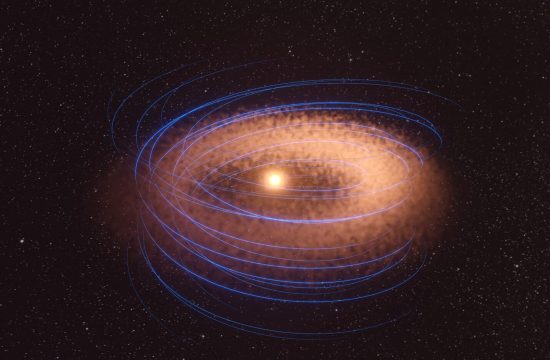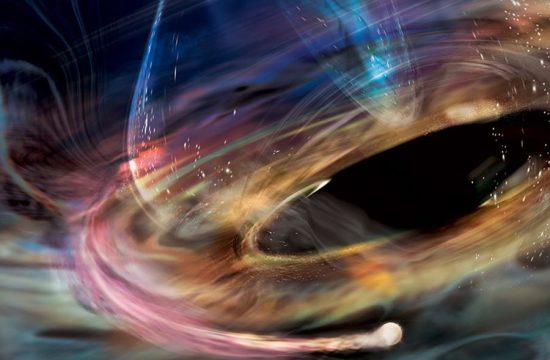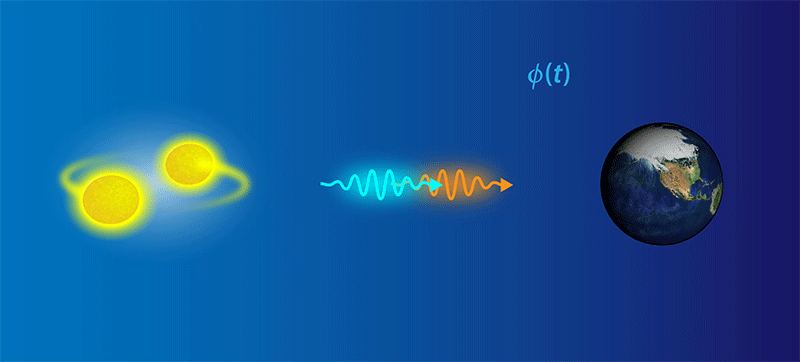
Theorists have tightly constrained alternative theories of gravity using the recent joint detection of gravitational waves and light from a neutron star merger.
Our current theory of gravity, general relativity (GR), has been spectacularly successful. It accurately describes the dynamics of astronomical objects over a vast range of sizes from planets and stars, to black holes, all the way to galaxies. GR also predicts the expansion of the Universe as a whole.
But the theory has fallen short in one respect: explaining the finding that the Universe is expanding at an accelerating rate. According to GR, the sum of all known radiation, visible matter, and dark matter should exert an inward “tug” on the Universe, slowing down its rate of expansion over time. So to account for acceleration, physicists have been forced to consider three possibilities [1], all of which are often loosely referred to as “dark energy.” The first option—and also the simplest and most favored—is the existence of a cosmological constant, or vacuum energy, which counteracts gravity by exerting a constant negative effective pressure. The second imagines that the cosmological constant is actually dynamical. Finally, the third possibility is that gravity behaves differently on large distance scales, requiring a modification of GR. Using the recent detection of a gravitational wave and light from a distant binary neutron merger, four research groups have now placed some of the tightest constraints to date on this third scenario [2–5].
The extraordinary observation that made this work possible occurred on August 17, 2017, when the gravitational-wave detectors at the Advanced LIGO and Advanced Virgo experiments picked up a loud signal [6]. Within 2 s of the event, known as GW170817, an instrument onboard the Fermi gamma-ray satellite detected a short burst of gamma rays from a similar location in the sky [7]. Follow-up observations by telescopes across the globe confirmed that the gravitational wave and gamma rays came from the same source—a binary neutron star merger in the NGC 4993 galaxy, approximately 130 million light years away from Earth (see 16 October 2017 Viewpoint). The fact that the two signals traveled from such a great distance, yet arrived at Earth just a few seconds apart, implies that gravitational waves travel at the same speed as light to within 1 part in 10151015 [8]. Previous constraints on the relative speeds had only been at the level of 1 part in 5, so this single observation improved our knowledge of a fundamental property of nature by 14 orders of magnitude.
To understand how GW170817 provides a stringent test for alternative gravity theories requires some background. GR is, in some sense, simple, involving just one dynamical field whose massless excitations are gravitational waves that travel at the speed of light. Theories that go beyond GR plus a cosmological constant generally do so by introducing new dynamical fields. In the simplest and most frequently studied cases, this entails coupling gravity to a light scalar field, which can vary in time and/or space. The most general example of this approach is an extension of a theory first derived by Gregory Horndeski [9] known as beyond-Horndeski theory. Some representatives of this class of theories, known as disformal theories, allow gravitational waves to “mix” with the scalar field, which modifies the speed of a gravitational wave as it travels through space. Roughly speaking, gravitational waves traveling through the background scalar field experience a “medium” with a refractive index other than 1. (Fig. 1).
Now, in order to produce cosmic acceleration, the scalar field has to have a nonzero, time-dependent cosmological background value, denoted φ(t)?(t). Assuming the field evolves on the natural time scale of cosmology—the Hubble time scale of about 10 billion years—it would induce a relative change in the speed of a gravitational wave of anywhere between 10% and 100%. Following this argument, the four research teams use the near-identical speeds of light and gravitational waves measured in GW170817 to rule out any cosmologically relevant scalar field in disformal theories of gravity [2–5].
The papers present particularly severe constraints on what is known as the covariant Galileon model. This popular model is characterized by four free parameters and allows for acceleration without a cosmological constant. But GW170817 implies a near vanishing of two of these parameters when one uses the model to derive the modified wave equation for gravitational waves. This is shown by three of the teams: Tessa Baker of the University of Oxford, UK [2], and colleagues; Paolo Creminelli of the Abdus Salam International Centre for Theoretical Physics, Italy, and Filippo Vernizzi of the CEA Saclay, France [3]; and Jose María Ezquiaga of the Autonomous University of Madrid and Miguel Zumalacárregui of the University of California, Berkeley [5].
Their results could be the death knell for covariant Galileons. Although the remaining two parameters in the theory can still be adjusted to yield an accelerating Universe, these adjusted values are incompatible with a variety of other cosmological observations, such as the correlation between galaxy distributions and the cosmic microwave background. This is a beautiful example of how multiple observables are needed to test acceleration models [10]. Indeed, the fourth paper in the quartet, by Jeremy Sakstein and Bhuvnesh Jain at the University of Pennsylvania, Philadelphia, uses GW170817 and other astrophysical observations to rule out a narrower subclass of covariant Galileons. Figure 2 in the paper by Ezquiaga and Zumalacárregui [5] also offers a particularly useful summary of which alternative gravity models are ruled out by GW170817 and which ones are still allowed (albeit possibly constrained by other measurements).
Looking beyond scalar fields, Baker and colleagues found that GW170817 places tight constraints on dark energy models that involve coupling gravity to vector fields [2]. Similarly, a preprint uses the gravitational-wave event to constrain models that attempt to explain the dynamics of galaxies and other cosmological objects without dark matter [11]. Interestingly, GW170817 also provides strong independent evidence for dark matter’s effect on gravitational waves: From observing the effects of gravitational lensing on other astrophysical objects, we know that dark matter has warped the space time through which the light from the neutron star merger traveled, delaying the light’s arrival time on Earth by a few years. GW170817 indicates that gravitational waves must have experienced exactly the same delay.
GW170817 has had a surprisingly big impact on the field of dark energy, ruling out a significant fraction—though most definitely not all—of the parameter space of theories involving a scalar field coupled to gravity. Now that the gravitational-wave window is ajar, we can soon expect the detection of many more events like GW170817. These will likely offer new ways to probe gravity and the physics behind the acceleration of the Universe. For now, the burden is on theorists who aren’t satisfied with the remaining viable models to imagine new scenarios for acceleration that don’t modify the propagation speed of gravitational waves.
This research is published in Physical Review Letters.
References
- A. Joyce, L. Lombriser, and F. Schmidt, “Dark Energy Versus Modified Gravity,” Annu. Rev. Nucl. Part. Sci. 66, 95 (2016).
- T. Baker, E. Bellini, P. G. Ferreira, M. Lagos, J. Noller, and I. Sawicki, “Strong Constraints on Cosmological Gravity from GW170817 and GRB 170817A,” Phys. Rev. Lett. 119, 251301 (2017).
- P. Creminelli and F. Vernizzi, “Dark Energy after GW170817 and GRB170817A,” Phys. Rev. Lett. 119, 251302 (2017).
- J. Sakstein and J. Jain, “Implications of the Neutron Star Merger GW170817 for Cosmological Scalar-Tensor Theories,” Phys. Rev. Lett. 119, 251303 (2017).
- J. M. Ezquiaga and M. Zumalacárregui, “Dark Energy after GW170817: Dead Ends and the Road Ahead,” Phys. Rev. Lett. 119, 251304 (2017).
- B. P. Abbott et al. (LIGO Scientific Collaboration and Virgo Collaboration), “GW170817: Observation of Gravitational Waves from a Binary Neutron Star Inspiral,” Phys. Rev. Lett. 119, 161101 (2017).
- A. Goldstein et al., “An Ordinary Short Gamma-Ray Burst with Extraordinary Implications: Fermi-GBM Detection of GRB 170817A,” Astrophys. J. Lett. 848, L14 (2017).
- B. P. Abbott et al., “Gravitational Waves and Gamma-Rays from a Binary Neutron Star Merger: GW170817 and GRB 170817A,” Astrophys. J. Lett. 848, L13 (2017).
- G. W. Horndeski, “Second-Order Scalar-Tensor Field Equations in a Four-Dimensional Space,” Int. J. Theor. Phys. 10, 363 (1974).
- J. Renk, M. Zumalacárregui, F. Montanari, and A. Barreira, “Galileon Gravity in Light of ISW, CMB, BAO and H0 Data,” J. Cosmol. Astropart. Phys. 10, 020 (2017).
- S. Boran, S. Desai, E. Kahya, and R. Woodard, “GW170817 Falsifies Dark Matter Emulators,” arXiv:1710.06168.
Original article is published on APS


